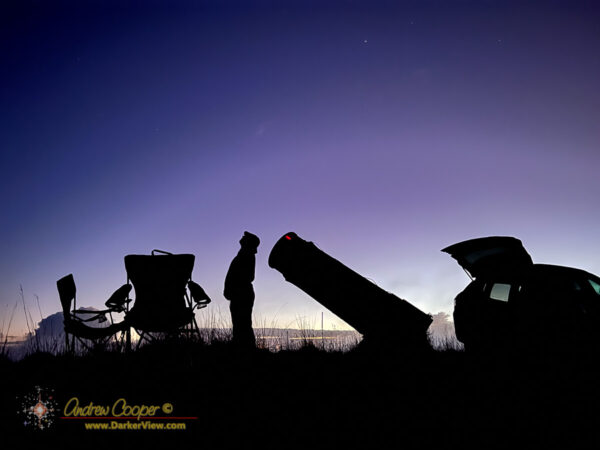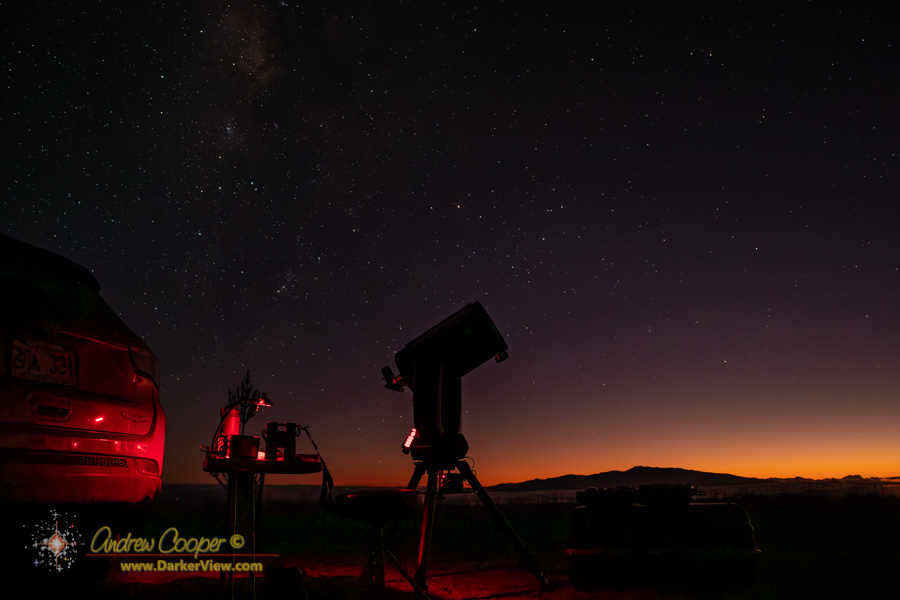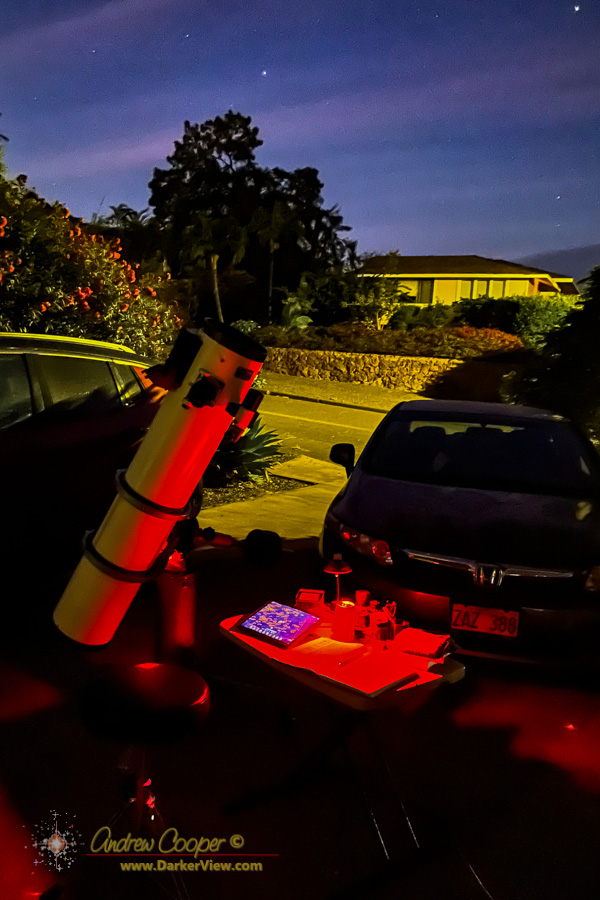
Awaiting Dark

When you want to see the stars, find someplace dark

While I have gotten plenty of telescope time lately, it has usually been morning sessions with the old Astrola in my driveway. This is a low effort and thoroughly enjoyable practice that I engage in about half a dozen times each month. Such sessions do mean that my 18″ telescope languishes for far too long in the garage.
I really need to change that.
Thus when my fellow staff at Symbrosia start asking for another star party it made a good excuse to get the big ‘scope out of the garage and under a dark sky.
Continue reading “A Misty Night at Kaʻohe”
First quarter moon… Telescope time.
I find myself reliably rising early, often around 4am, something that seemed to have begun during the pandemic. Those who knew me in my younger years may find this a bit unbeliveable, I used to hate mornings, but now?
The other factoid about island mornings. It is almost always clear. The afternoon and evening clouds have dissipated and clear skies are the rule.
Combine these bits with a love of the sky and the result is morning observing sessions, often half a dozen mornings will be spent out with a telescope in those couple weeks the Moon is absent from the morning sky.
Get up, shrug on some ratty old clothes, and wheel the telescope out of the garage. The ‘scope of choice is almost always the old Astrola, even with larger and more sophisticated telescopes available there is just something about using that old manual ‘scope that I find satisfying.
Perhaps the lack of computer or digital setting circles means it is my own skill enabling my path among the stars. The Astrola does have manual setting circles, but I rarely use those. A star chart, a finder, and starhopping allow me to wander through rather than jump about… I just see more, often stumbling across unexpected bits of beauty.
I have upgraded the Astrola a bit lately, adding a larger finder ‘scope with a wide field eyepiece. It is a 50mm 3D printed finder of my own design allowing me to see more sky at once with fainter stars.
There are a few more days until the bright Moon crosses into the morning sky, a few more mornings you will likely find me out with the ‘scope.
A dark clear night at Kaʻohe, just the thing I needed. A telescope… A dark sky.
There had been plans of a few friends from work, but with a virus rampaging through the crew a social event did not seem like a great idea. Will have to do the invitations another time. This evening would be a solo run.
No big production… Toss the gear in the vehicle… The Nexstar 11″ ‘scope, a few munchies and a thermos of hot tea, a table, a notebook, and go.
The night was nearly perfect, no wind, not all that cold, a few wisps of cloud that dissipated after sunset.
I would work the southern horizon this night, as low as I can go from 20°N latitude. From the Kaʻohe site due south is right over the summit of Mauna Loa. Just above the shadowy outline of the caldera I would catch stars and galaxies as they transited. Constellations unknown and inaccessible to northern observers… Pavo, Grus, and Phoenix. Some of the objects I observed were in the lower -60° declinations…
φ2 Pav Pale yellow, no companion noted, φ1 Pav is visible 33′ west
Andrew Cooper, 7 Oct 2023
NGC 7582 Bright and obvious, extended 5′ x 2′ northwest-southeast, brighter to the center without a notable core, NGC 7590 and NGC 7599 visible 10′ northeast, NGC 7552 visible 28′ southwest, the Grus Quartet makes an entrancing field with four bright galaxies
NGC 45 Quite faint and diffuse, difficult, about 5′ diameter, a slight brightening to the center, a 10th magnitude star in the southeast quadrant, the 7th magnitude star HD 941 is about 5′ southwest
NGC 7155 Small, faint, round with a stellar core, at the center of an east-west 15′ arc of 11th to 12th magnitude stars
A good night out with a telescope, packing it in about midnight as to not totally wreck my sleep pattern. Still, I got in five hours of observing.
I have been getting quite a bit of telescope time in lately, mostly in the driveway, usually using the old 8″ Astrola. I find myself awake at 4am often enough, and can get in a pleasant hour of observing before dawn.

A large star party is an experience worth seeking out… Hundreds of people, hundreds of telescopes, all under a dark sky.
A star party is a meeting of geeks. Technical talk of optics, electronics, and fabrication techniques like 3D printing abounds. In the afternoon and evening you will find small conversations in the shade, pull up a chair and join the discussion.
The plan was something I had executed successfully before… Fly into Portland, spend some time with my folks, then borrow the family camper for the trip out to the Ochoco Mountains for the star party.
Continue reading “Oregon Star Party 2023”Wandering the sky using a telescope and a field guide published in 1844, the better part of two centuries ago, is… uhhm… interesting. In mid-April the classic winter constellations are dissapearing into the sunset, with constellations like Monocerus and Puppis well placed for observing from my driveway just after dark. On my observing table is a reprint of that 1844 field guide, The Bedford Cycle.
Working through the entries I come to the entry for a double star Argo Navis 72 P. VIII, a designation from a very old catalog. It takes a few moments research to convert 72 P. VIII to the slightly more modern catalog number HD 71176. Modern? The Henry Draper Catalog was first published by Harvard Observatory in 1918, still over a century ago.
With the HD number I can look up the position on a modern chart and spend a few moments star-hopping the Astrola to the correct star. This double star is now located in the constellation Puppis after the ancient and absurdly large constellation Argo Navis was broken up into Puppis, Vela, and Carina.
Continue reading “Of Green Stars…”A dark moon weekend? I had not been out in a while, time for some dark skies with a telescope. This night had been scheduled for a while, the folks I work with keep asking me about getting a look through one of my big ‘scopes. Thus this night had been set aside on a calendar normally used for staff meetings and investor conference calls.
Where? Kaʻohe of course, the best place for this on the west side, easy range for my friends coming up from Kona.
Everone arrived on schedule at sunset, car pooling up from Kona. Greeted by a spectacular sky, a slim crescent Moon seeting into the golden glow of Hualalai, the bright planets Venus and Jupiter appearing in the gloaming.
Continue reading “A Bright Night at Kaʻohe”